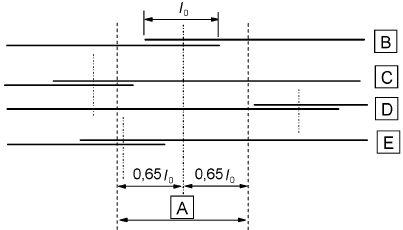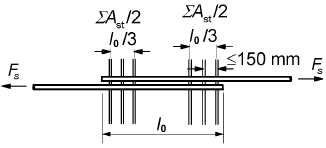EC2: Lap length of reinforcements
8.7 Laps and mechanical couplers
8.7.1 General
(1)P Forces are transmitted from one bar to another by:
- lapping of bars, with or without bends or hooks;
- welding;
- mechanical devices assuring load transfer in tension-compression or in compression only.
8.7.2 Laps
(1)P The detailing of laps between bars shall be such that:
- the transmission of the forces from one bar to the next is assured;
- spalling of the concrete in the neighbourhood of the joints does not occur;
- large cracks which affect the petiormance of the structure do not occur.
(2) Laps:
- between bars should normally be staggered and not located in areas of high moments Iforces (e.g. plastic hinges). Exceptions are given in (4) below;
- at any section should normally be arranged symmetrically.
(3) The arrangement of lapped bars should comply with Figure 8.7:
- the clear distance between lapped bars should not be greater than 4Φ or 50 mm, otherwise the lap length should be increased by a length equal to the clear space where it exceeds 4Φ or 50 mm;
- the longitudinal distance between two adjacent laps should not be less than 0,3 times the lap length, 10;
- In case of adjacent laps, the clear distance between adjacent bars should not be less than 2Φ or 20 mm.
(4) When the provisions comply with (3) above, the permissible percentage of lapped bars in tension may be 100% where the bars are all in one layer. Where the bars are in several layers the percentage should be reduced to 50%.

Figure 8.7: Adjacent laps
8.7.3 Lap length
(1) The design lap length is:
where:
- lb,rqd is calculated from Expression (8.3)
- l0,min ≥ max{0.3 α6 lb,rqd; 15Φ; 200 mm}(8.11)
- Values of α1, α2, α3 and α5 may be taken from Table 8.2; however, for the calculation of α3, ∑Ast,min should be taken as 1.0·As(σsd / fyd), with As = area of one lapped bar.
- α6 = (ρ1/25)0.5 but not exceeding 1.5 nor less than 1.0, where ρ1 is the percentage of reinforcement lapped within 0.65·l0 from the centre of the lap length considered (see Figure 8.8). Values of α6 are given in Table 8.3.
Table 8.3: Values of the coefficient α6
| Percentage of lapped bars relative to the total cross-section area | < 25% | 33% | 50% | >50% |
| α6 | 1 | 1,15 | 1,4 | 1,5 |
| Note: Intermediate values may be determined by interpolation. | ||||

![]()
Example: Bars II and III are outside the section being considered: % 50 and α6=1,4
Figure 8.8: Percentage of lapped bars in one lapped section
8.7.4 Transverse reinforcement in the lap zone
8.7.4.1 Transverse reinforcement for bars in tension
(1) Transverse reinforcement is required in the lap zone to resist transverse tension forces.
(2) Where the diameter, Φ, of the lapped bars is less than 20 mm, or the percentage of lapped bars in any section is less than 25%, then any transverse reinforcement or links necessary for other reasons may be assumed sufficient for the transverse tensile forces without further justification.
(3) Where the diameter, Φ, of the lapped bars is greater than or equal to 20 mm, the transverse reinforcement should have a total area, ∑Ast (sum of all legs parallel to the layer of the spliced reinforcement) of not less than the area As of one lapped bar (∑Ast ≥ 1.0·As). The transverse bar should be placed perpendicular to the direction of the lapped reinforcement, and between lap bar and the concrete surface.
If more than 50% of the reinforcement is lapped at one point and the distance, a, between adjacent laps at a section is ≤ 10·Φ (see Figure 8.7) transverse reinforcement should be formed by links or U bars anchored into the body of the section.
(4) The transverse reinforcement provided for (3) above should be positioned at the outer sections of the lap as shown in Figure 8.9(a).
8.7.4.2 Transverse reinforcenlent for bars permanently in compression
(1) In addition to the rules for bars in tension one bar of the transverse reinforcement should be placed outside each end of the lap length and within 4Φ of the ends of the lap length (Figure 8.9b).

a) bars in tension

b) bars in compression
Figure 8.9: Transverse reinforcement for lapped splices




